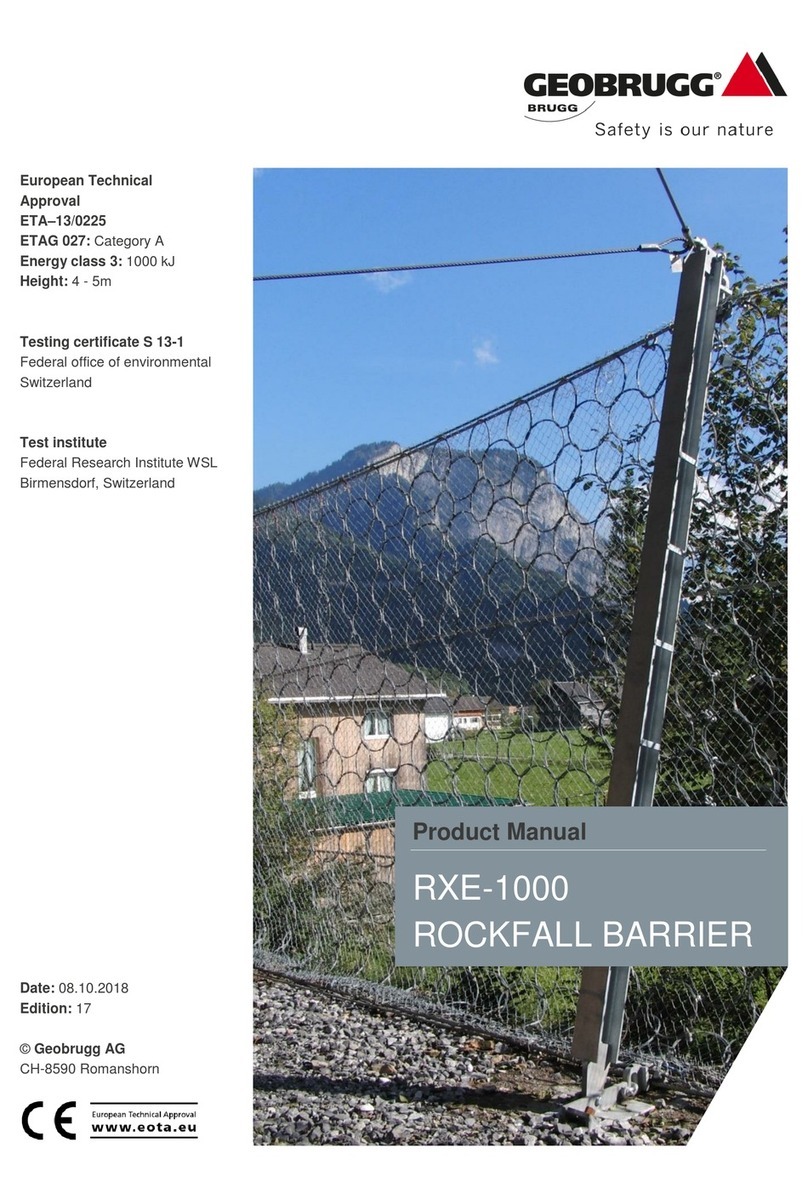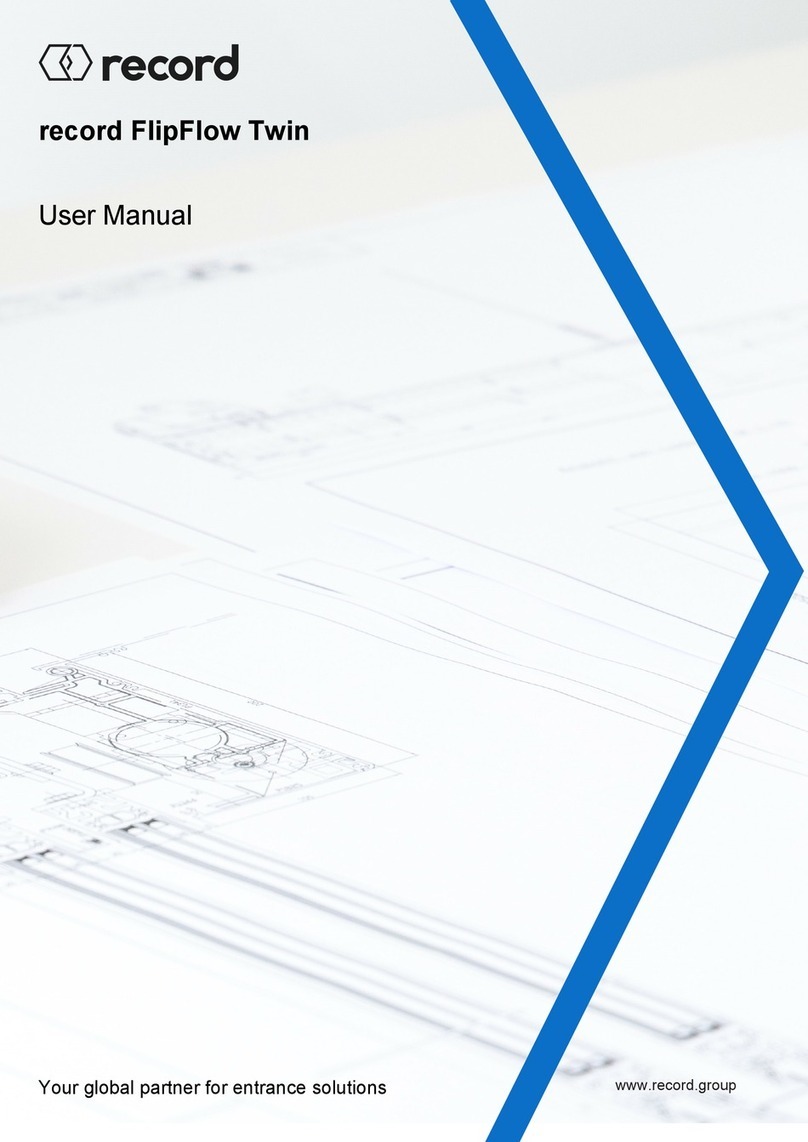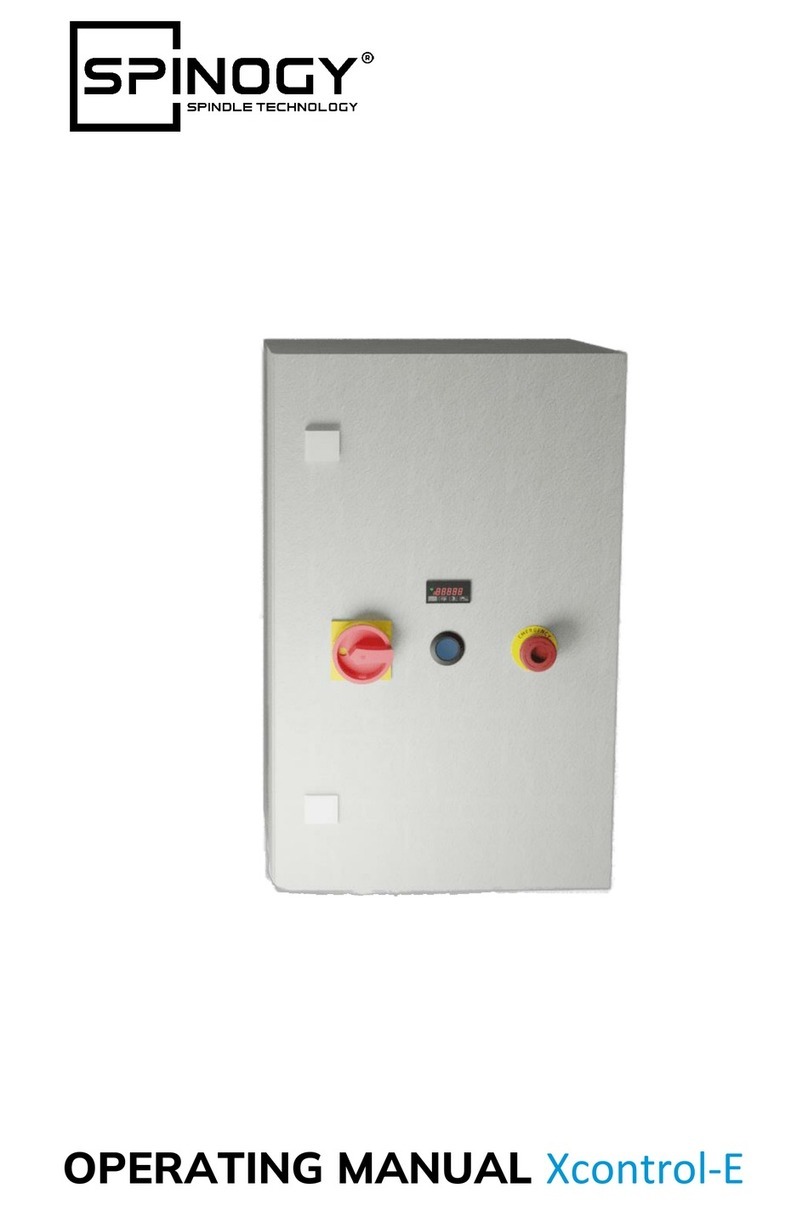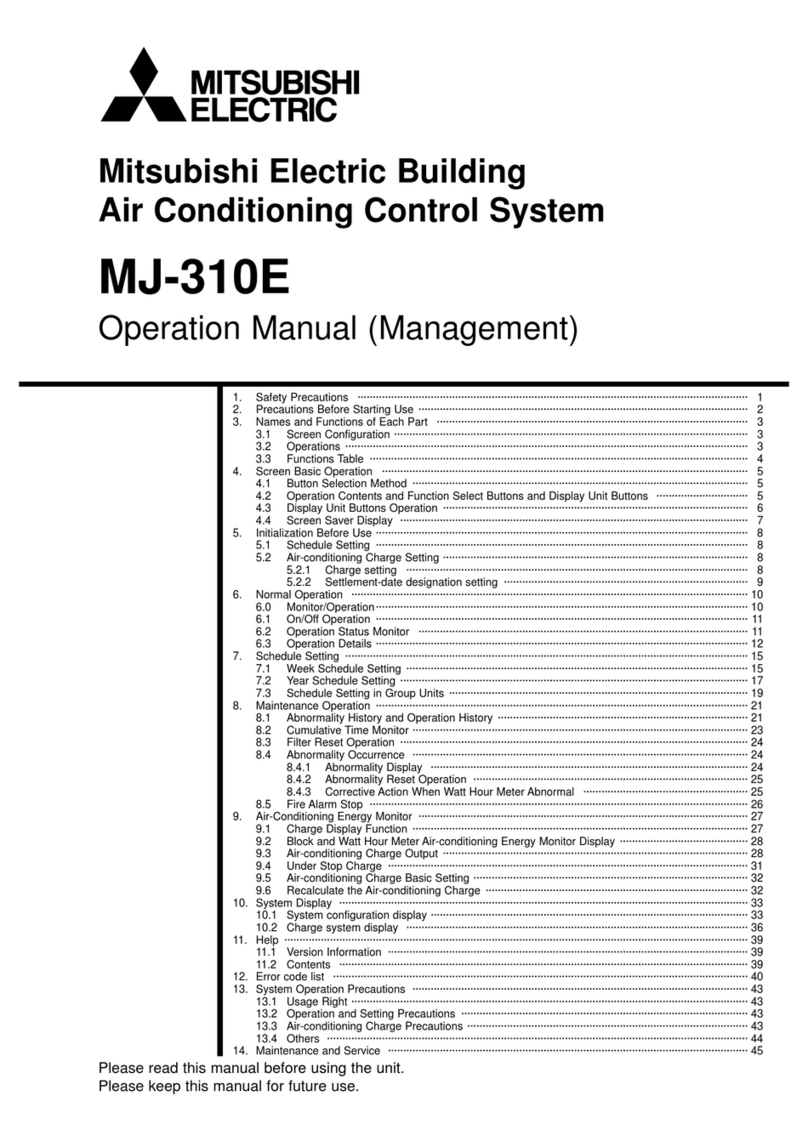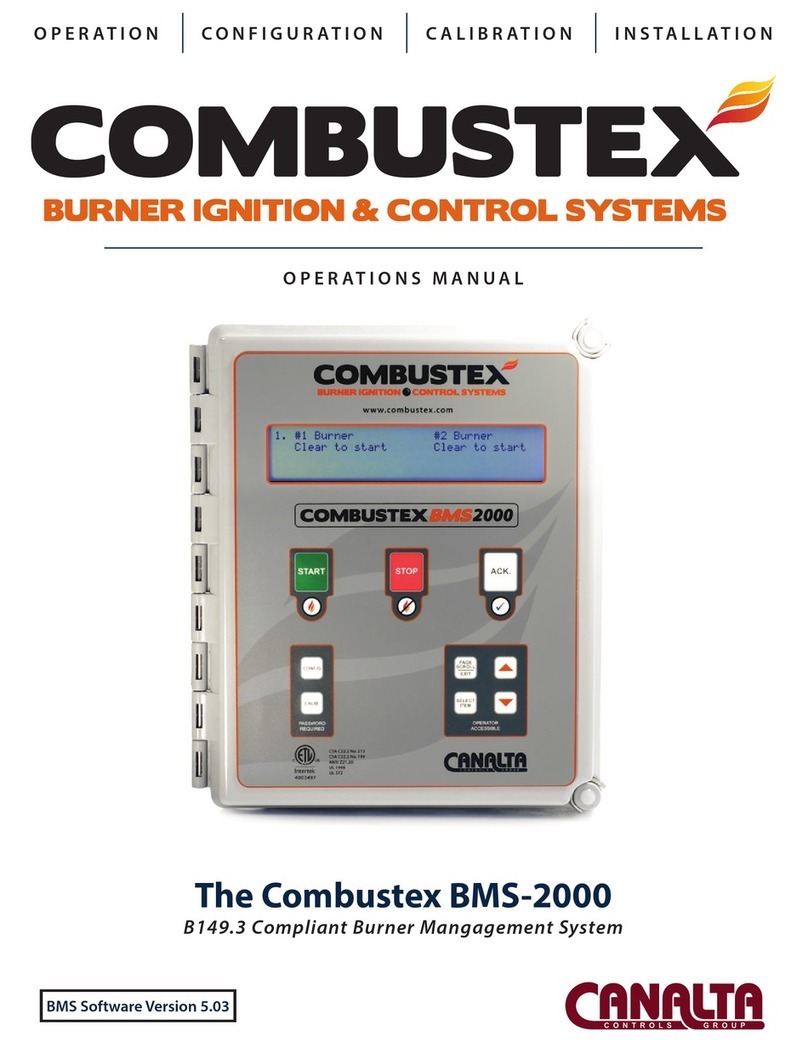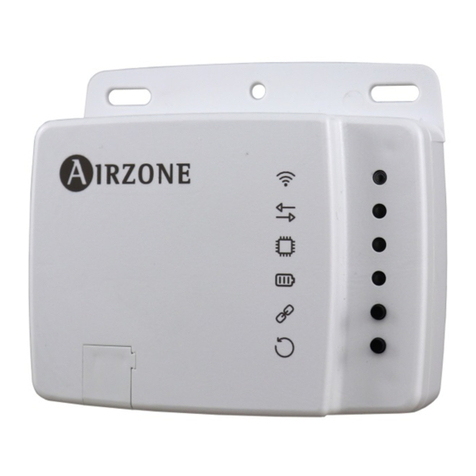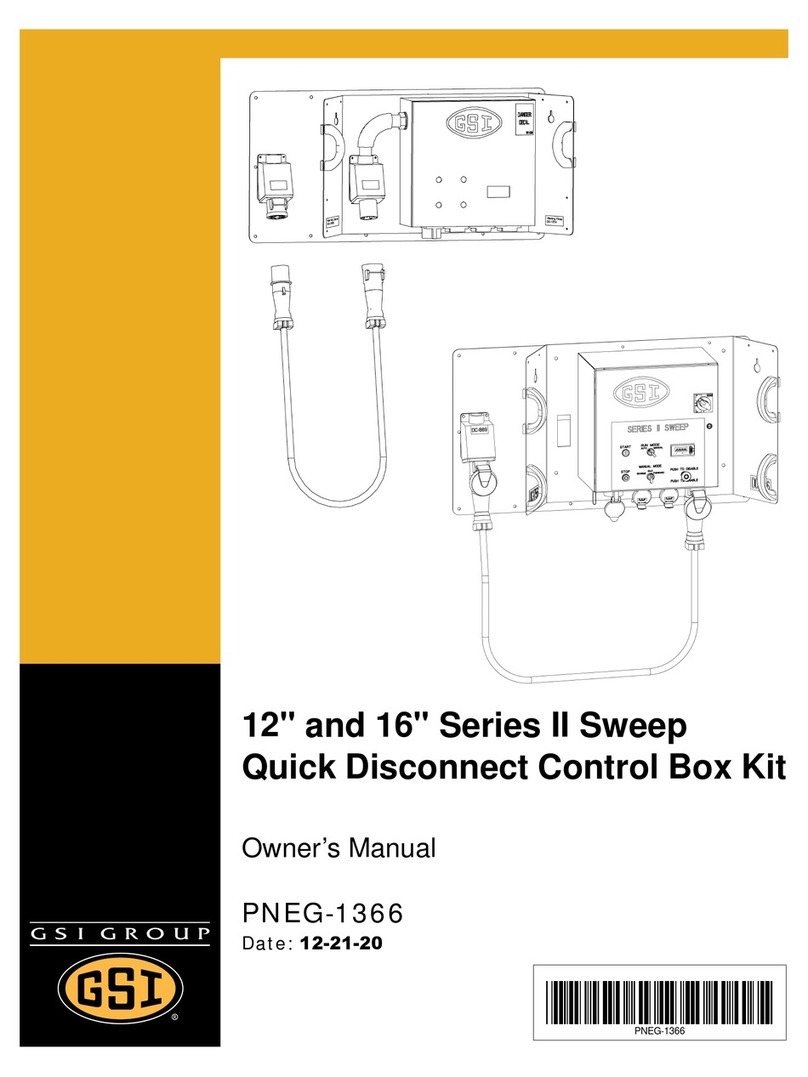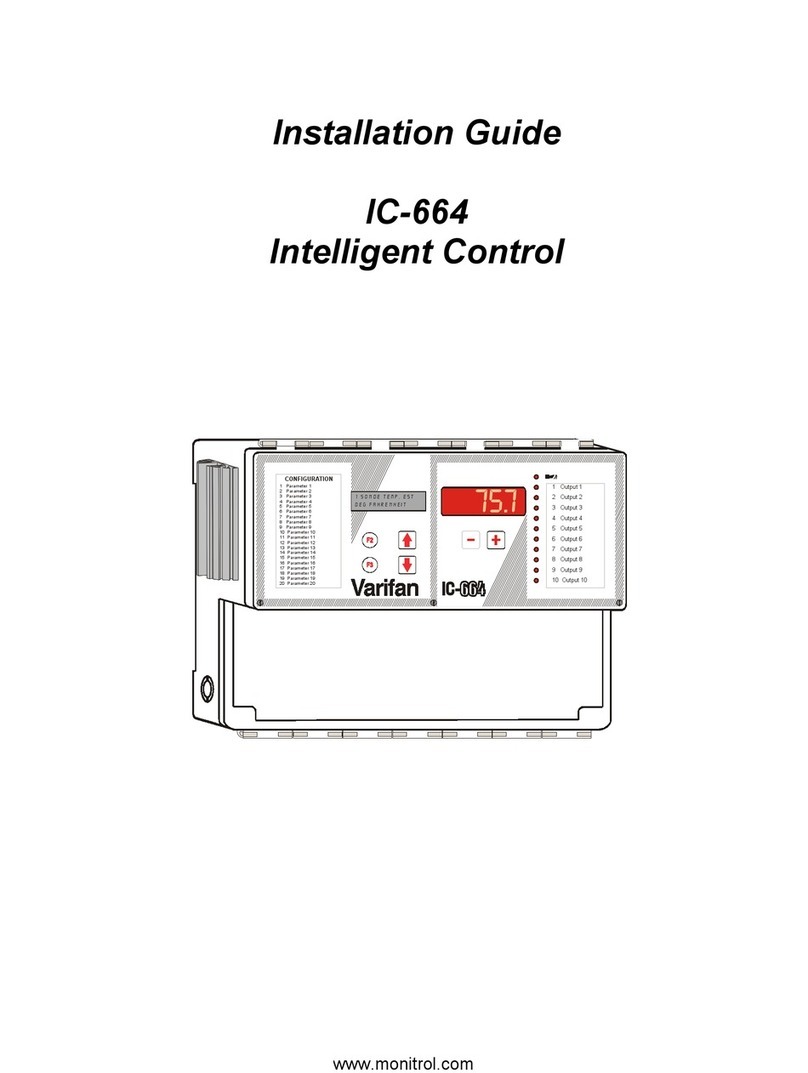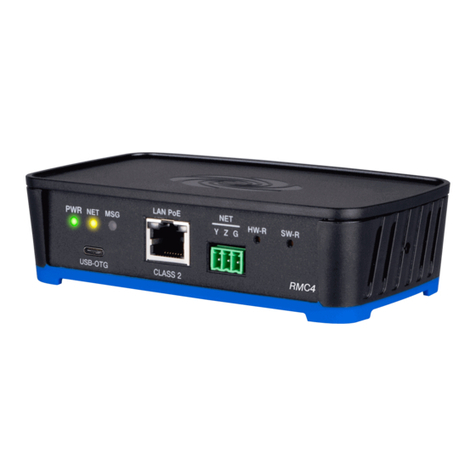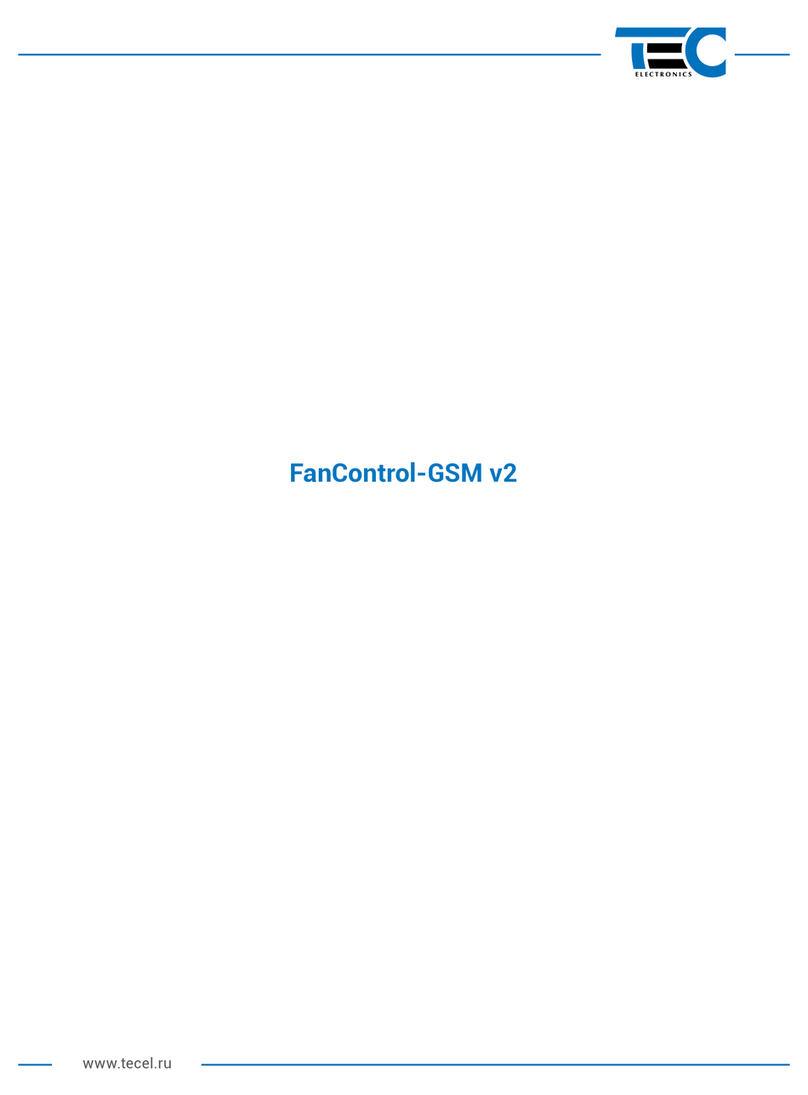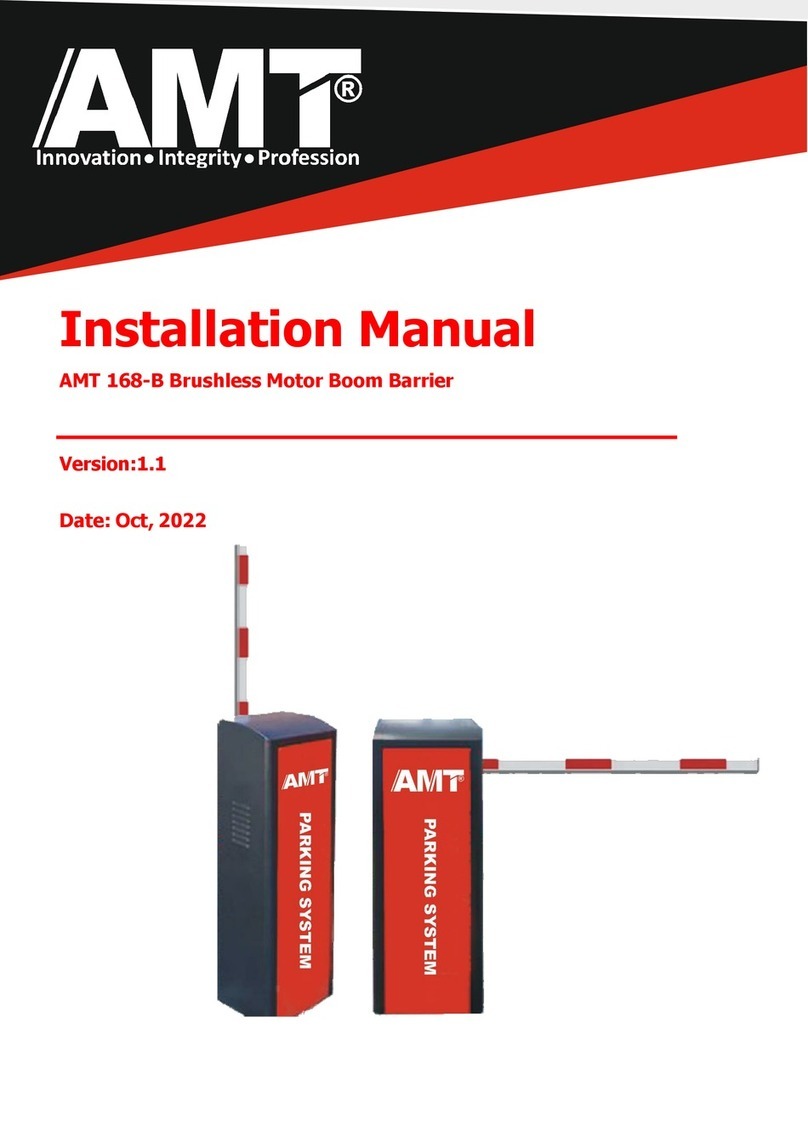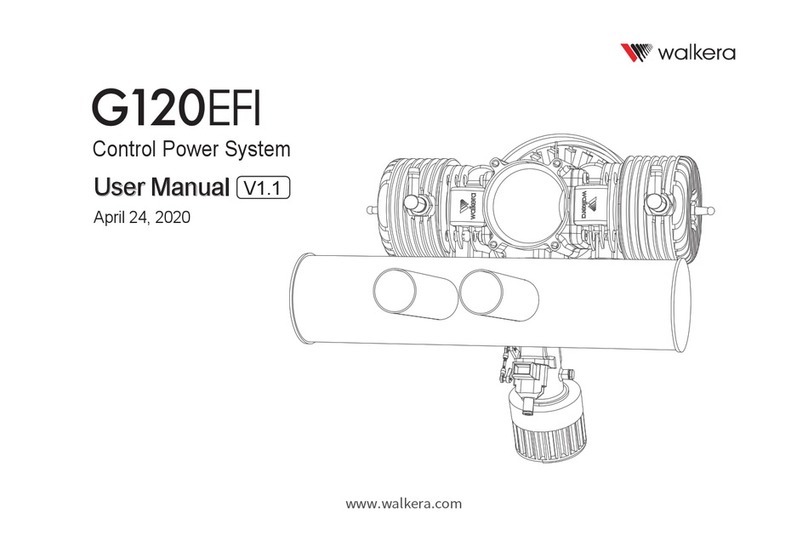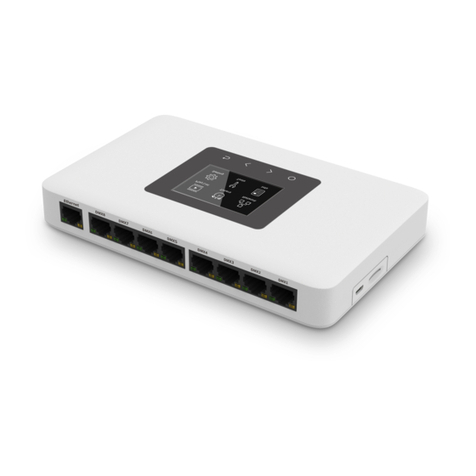Geobrugg GBE-500A-R User manual

European Technical
Assessment ETA 16/0329
ETAG 027: Category A
Energy class 2: ≥500 kJ
Height: 3 – 3.5 m
Associated test institute:
Swiss Federal Institute for
Forest, Snow and Landscape
Research WSL
Birmensdorf, Switzerland
Date: 08.10.2018
Edition: 15
© Geobrugg AG
CH-8590 Romanshorn
Product Manual
GBE-500A-R
ROCKFALL BARRIER

Page 2/39
© Geobrugg AG, CH-8590 Romanshorn, Switzerland GBE-500A-R / 15

Page 3/39
© Geobrugg AG, CH-8590 Romanshorn, Switzerland GBE-500A-R / 15

Page 4/39
© Geobrugg AG, CH-8590 Romanshorn, Switzerland GBE-500A-R / 15
PURPOSE AND ORGANIZATION OF THE MANUAL
This product manual ensures that Geobrugg Rockfall protection systems are manufactured free from defects in
accordance with the latest technology and that the range of applications is clearly defined, the functional efficien-
cy is given, and the installation of the system is professionally carried out and controlled.
For an overview of the system, see the appendix at the end of this manual
The product manual is divided into the following sections:
•Proof of quality assurance
•Installation manual
•System drawing / rope assembly drawing
•ISO 9001 certificate
No claims are made that this document is complete. The manual describes standard applications and does not
take into account project-specific parameters. Geobrugg cannot be held liable for any extra costs that may be in-
curred for special cases. In case of uncertainties, please contact the manufacturer. The General Sales Conditions
of Geobrugg AG are applicable.
RESPONSIBILITY FOR THE CONTENT:
Geobrugg AG
Protection Systems
Aachstrasse 11
PO Box
CH-8590 Romanshorn, Switzerland
www.geobrugg.com
Romanshorn, 08.10 2018
(Stamp / legally valid signatures)

Page 5/39
© Geobrugg AG, CH-8590 Romanshorn, Switzerland GBE-500A-R / 15
I RANGE OF APPLICATION
The engineering of rockfall protection systems is based on detailed investigations by specialist engineering com-
panies, which take the following geotechnical aspects in particular into account to define the range of applica-
tions:
•Previous rockfall events
•Condition of the rockfall breakout zone
•Assessment of the stability of the entire rockfall zone
•Frequency of rockfall
•Size of the rocks to be caught
•Trajectories and bounce heights of the rocks
•Calculations of the kinetic energy
•Barrier position (taking the local topography into account)
•Anchoring conditions
II QUALITY OF THE INDIVIDUAL SYSTEM COMPONENTS
Geobrugg AG, previously the Geobrugg Protection Systems department of Fatzer AG, based in Romanshorn,
Switzerland, has been certified to quality management system requirements (ISO 9001:2008) since August 22,
1995, registered under the number CH-34372. The certifying body is the SQS (the Swiss Association for Quality
and Management Systems), to which IQNet belongs. The Quality Manual provides complete information on how
individual system parts (primary material, commercial products and end products) must undergo extensive testing
to rule out insufficient quality.
III FUNCTIONAL RELIABILITY OF THE BARRIER SYSTEMS
The system's functional reliability is based on 1:1 rockfall tests, performed and tested in accordance with Europe-
an Technical Approval Guideline ETAG 027 "Falling Rock Protection Kits" in Walenstadt, SG (Switzerland). The
1:1 rockfall tests involve performing vertical impacts into the middle field of a three-field barrier, where the posts
are spaced at 10 m and an impact speed of at least 25 m/s is reached. The tests are accepted by a notified body
and receive an approval, known as an ETA (European Technical Approval). The approval no. of the GBE-500A-R
system is ETA –16/0329.
IV QUALITY CONTROL FOR INSTALLATION
This system manual provides a detailed description of how to design and install the barrier.

Page 6/39
© Geobrugg AG, CH-8590 Romanshorn, Switzerland GBE-500A-R / 15
V PRODUCT LIABILITY
Rockfall, landslides, debris flows or avalanches are sporadic and unpredictable. The cause is human (buildings,
etc.), for example, or forces beyond human control (weather, earthquakes, etc.). The multiplicity of factors that
may trigger such events means that guaranteeing the safety of persons and property is not an exact science.
However, the risks of injury and loss of property can be substantially reduced by appropriate calculations that ap-
ply good engineering practices, and by using predictable parameters along with the corresponding implementa-
tion of flawless protective measures in identified risk areas.
Monitoring and maintenance of such systems are an absolute requirement to ensure the desired safety level.
System safety can also be diminished through events, natural disasters, inadequate dimensioning or failure to
use standard components, systems and original parts, but also through corrosion (caused by environmental pollu-
tion or other man-made factors as well as other external influences).
In contrast to the one-to-one rockfall tests, which indeed test an extreme load case but still only demonstrate a
standardized situation, in the field the layout and design of a protection system can vary greatly because of the
topography. The influence of such alterations and adaptations cannot always be determined exactly. Critical
points are, for example, post spacing, changes in direction, placement angle of the rope anchor, and the direction
and velocity of impact.
Geobrugg can assist with estimating the influence of larger deviations and special situations, and can offer rec-
ommendations for feasible solutions. Geobrugg cannot, however, guarantee the same behaviour as in the one-to-
one rockfall tests. In critical cases, it is advisable to reinforce particular components as compared with the stand-
ard barrier.

Page 7/39
© Geobrugg AG, CH-8590 Romanshorn, Switzerland GBE-500A-R / 15
TABLE OF CONTENTS
1HAZARD WARNINGS ......................................................................................................... 8
2TOOLS FOR INSTALLING ROCKFALL BARRIERS ............................................................. 9
3USING THE WIRE ROPE CLIPS ....................................................................................... 10
4STAKING OUT SUBJECT TO TERRAIN ........................................................................... 12
5STAKING-OUT GEOMETRY ............................................................................................. 14
6ANCHORING THE BASEPLATE ....................................................................................... 18
7PREPARING THE POSTS AND NETS ............................................................................... 20
8CRANE OR HELICOPTER INSTALLATION ....................................................................... 23
9INSTALLING THE SUPERSTRUCTURE ........................................................................... 24
10 ASSEMBLY DETAILS ....................................................................................................... 26
11 ADDITIONAL SOLUTION TO THE STANDARD................................................................. 35
12 FINAL INSPECTION......................................................................................................... 36

Page 8/39
© Geobrugg AG, CH-8590 Romanshorn, Switzerland GBE-500A-R / 15
EXPLANATION OF SYMBOLS USED
Safety instruction: must be strictly observed
Note / reminder to enable system to be installed easily and correctly
Consultation with Geobrugg is recommended
Mountain-side
Valley-side
1 HAZARD WARNINGS
GROUP LEADER QUALIFICATIONS
Only a qualified group leader may be responsible for overseeing the installation.
ROPES UNDER TENSION
Ropes are under tension. During the installation and tensioning of the ropes, you must make sure that no
persons are present in the hazard area.
REMOVAL OF PARTS UNDER TENSION
The removal or separation of components under tension is to be avoided whenever possible. Should such
work be necessary, however, the utmost caution must be taken.

Page 9/39
© Geobrugg AG, CH-8590 Romanshorn, Switzerland GBE-500A-R / 15
2 TOOLS FOR INSTALLING ROCKFALL BARRIERS
STAKING-OUT WORK
•30 –50 m measuring tape
•Measure stick
•5 red and white ranging poles
•Inclinometer
•Spray can
•Wooden peg or iron peg (min. 3x for each field)
•Hammer/mallet
•Manual
INSTALLATION WORK
•Open-ended or ring wrench
•Socket wrench set with ratchet
•Torque wrench, range 25 –400 Nm (see tightening torque required for wire rope clips and base
plate fastening nuts)
•Open-ended wrench for base plate fastening nuts
•Felco C16 or C112 wire rope cutter or similar; 12 mm cutting capacity
•Cutting-Off wheel or hammer wire cutter; 28 mm cutting capacity
•pincers, flat-nose pliers
•2 mm galvanized wire strands or wire
•Angle spirit level
•Roll of adhesive tape
•Rope clamp, small 8 –16 mm / large 14 –26 mm (min. 2x)
•At least 2 tension belts
•Cable winch hoist, e.g. LUG-ALL®
•Chain hoist or HABEGGER wire rope hoist, min. 1.5 t (15 kN)
•Auxiliary ropes

Page 10/39
© Geobrugg AG, CH-8590 Romanshorn, Switzerland GBE-500A-R / 15
t
e
3 USING THE WIRE ROPE CLIPS
Instructions below apply to all wire rope clips according FF-C-450 type 1 class 1
(similar EN 13411-5 type 2) delivered by Geobrugg AG.
The distance ebetween the wire rope clips should be at least 1 x t but not exceed 2
x t , where tis the width of the clamping jaws. The loose rope end has to be 3 x e at
a minimum. Geobrugg recommends looping up the remaining free section and fixing
it directly behind the last wire rope clip on the tightened rope.
If you are using a thimble in the loop structure, the first wire rope clip must be at-
tached directly next to the thimble. For loops without a thimble the length hbetween
the first wire rope clip and the point of load incidence must minimally be 15-time the
nominal diameter of the rope. In unloaded condition the length hof the loop should
be not less than the double of the loop width h/2.
The clamping brackets (U-brackets) must always be fitted to the unstressed end of the rope, the clamping jaws
(saddle) must always be fitted to the strained rope („never saddle a dead horse“).
During tightening the nuts have to be tensioned equally (alternately) until the required tightening torque is
reached.
The required tightening torques with lubrication apply to wire rope clips whose
bearing surfaces and the threads of the nuts have been greased with Panolin CL
60 multipurpose lubricant spray (or an equivalent lubricant).
FF-C-450 type 1 class 1
min. 3 x e
h/2
h

Page 11/39
© Geobrugg AG, CH-8590 Romanshorn, Switzerland GBE-500A-R / 15
Wire rope di-
ameter
[mm]
Size
of the
wire rope clip
Required
amount of
wire rope clips
Required
tightening
torque lubricat-
ed
[Nm]
Required
tightening
torque
unlubricated
[Nm]
Wrench
size
[mm]
11 - 12
7/16“
3
40
110
22
14 - 15
9/16“
3
50
150
24
18 - 20
3/4‘‘
4
90
180
27
A visible contusion of the wire ropes positively indicates that the wire rope clips have been tightened to
the required tightening torque.
Undamaged wire rope clips could be reused. Especially the threads and clamping jaw have to be
checked.
Wire rope clips always have to be installed and used with the required tensioning torque.
After the first load application the tightening torque has to be checked and if
not fulfilled adjusted to the required value.

Page 12/39
© Geobrugg AG, CH-8590 Romanshorn, Switzerland GBE-500A-R / 15
4 STAKING OUT SUBJECT TO TERRAIN
GENERAL PRINCIPLES FOR STAKING OUT
Position of the barrier
Established simulation programs are available for calculating the optimum position of the barrier. Unfavourable
locations with excessive bounce heights or shadows are identified.
Barrier line
The barrier line must be designed so that it is as straight and horizontal as possible. An irregular course as well
as depressions and cambers in the terrain between the posts must be avoided or corrected wherever possible.
Placing the foundations
The baseplate support for the foundation must be designed based on the terrain so that the lower support rope
remains close to the ground.
The foundations must be placed in such a way that the lower support rope is routed past the edges of the founda-
tions without being damaged by them.

Page 13/39
© Geobrugg AG, CH-8590 Romanshorn, Switzerland GBE-500A-R / 15
Height differences in the barrier line
h: Barrier height
x: Distance between posts
n: Adjustment of the net lengths
h: Height difference between two adjacent posts
h< 2 m : No adjustment necessary
h> 2 m : Height difference outside standard staking-out parameters. Net must be adjusted
The standard net length is acceptable up to a height difference in the barrier line of 2 m and if the distance be-
tween the posts is between 6 m and 12 m.
If the height difference is greater than in Tab.2, you must contact Geobrugg to enable the correct length
of nets to be determined.
h
h
x
x
n

Page 14/39
© Geobrugg AG, CH-8590 Romanshorn, Switzerland GBE-500A-R / 15
5 STAKING-OUT GEOMETRY
GENERAL PRINCIPLES FOR STAKING-OUT GEOMETRY
Standard staking-out dimensions
If the standard staking-out dimensions shown on the following pages and their dimensional tolerances are ad-
hered to, the supplied barrier can be installed without any problems and every component will function correctly
should a rockfall event occur.
Adapting to the terrain
The type of terrain may mean that it is not possible to adhere to the standard staking-out parameters. Making a
number of small adjustments relating to the cross-section or length of nets, ropes, or posts, etc. will ensure that
the barrier will function correctly in these cases too.
Informing Geobrugg about the deviations enables you to work together to quickly find a solution that is
adapted to your requirements.
1)
Rope anchor
Lateral rope
2)
Change in direction towards the
mountain
Valley-side anchoring
3)
Intermediate anchor rope
with support rope separation
4)
Change in direction towards
the valley
Mountain-side anchoring
5)
Intermediate anchor
rope
without support rope
separation
1)
5)
3)
4)
2)

Page 15/39
© Geobrugg AG, CH-8590 Romanshorn, Switzerland GBE-500A-R / 15
STANDARD STAKING-OUT PARAMETERS FOR A STRAIGHT BARRIER LINE
ANCHOR POINT FOR INTERMEDIATE ANCHOR ROPE
a
x
c
A
B,C
D
c
a
a
Z
Z
The table below is valid for slopes of 30°- 90°.
Dimensions in m; Dimensional tolerance ± 0.20 m
h
a
c
e
2.00
3.00
0.65
1.00
3.00
4.50
1.00
1.50
3.50
5.30
1.15
1.75
4.00
6.00
1.30
2.00
Length
h: Barrier height
x: Distance between
posts
a: see Tab.3
c: see Tab.3
Anchor point
A: Upper support rope
B: Lower support rope
C: Lateral rope
1)
Tab. 3
Length
a: see Tab.3
c: see Tab.3
Anchor point
Z: intermediate
suspension

Page 16/39
© Geobrugg AG, CH-8590 Romanshorn, Switzerland GBE-500A-R / 15
CHANGE IN DIRECTION TOWARDS THE MOUNTAIN
In the case of a change in direction towards the mountain at an angle of 5° - 15°, valley-side anchoring (T) is ad-
ditionally required. The rope anchor will be positioned on the valley side at the distance (e) from the post.
The valley-side anchoring has a diameter of d = 12 mm.
e
T
5°<y<15°1)
x
2)
INTERMEDIATE ANCHOR ROPE
In the case of a change in direction towards the mountain of more than
15°, an intermediate anchor rope must be installed and the valley-side
anchoring is omitted.
Length
e: See Tab. 2
x: Distance between
posts
y: Angle of change in
direction
Anchor point
T: Valley-side
anchoring
5)
Length
a: see Tab.3
c: see Tab.3
y: angle of change in
direction
Anchor point
Z: intermediate
suspension
15°<y<25°
a
a
Z
Z
c
c

Page 17/39
© Geobrugg AG, CH-8590 Romanshorn, Switzerland GBE-500A-R / 15
ROPE ANCHORS FOR SUPPORT ROPE SEPARATION WITH INTERMEDIATE ANCHOR ROPE
A support rope separation also contains an intermediate anchor rope. In straightforward terrain conditions and
when using appropriate equipment, we recommend positioning a support rope separation after approx. 60 m –
100 m.
Note: In the case of changes in direction towards the mountain of more than 25°, support rope separation
must also be positioned for the intermediate anchor rope.
CHANGE IN DIRECTION TOWARDS THE VALLEY
In the case of a change in direction towards the valley of more than 30°, two additional retaining ropes (D) are
mounted on the post. The change in direction towards the valley must not exceed 40°.
c
a
a
B,Z
B,Z
30°<y<40°
a
Length
a: See Tab.3
c: See Tab.3
Anchor point
B: Lower support
rope
Z: Intermediate
anchor rope
3)
4)
Length
a: see Tab.3
y: angle of change i
direction
Anchor point
Z: intermediate suspension
Z
Z

Page 18/39
© Geobrugg AG, CH-8590 Romanshorn, Switzerland GBE-500A-R / 15
6 ANCHORING THE BASEPLATE
Loose ground:
•Drill holes for anchors
•Prepare the concrete foundations 111; the concrete founda-
tions are measured and reinforced in accordance with the
specifications of the project engineer
•Insert the anchors 05, spacers 09, and fastening nuts 10;
the project engineer calculates the anchor length
•Optional: Stabilization tube 04
•Using grout, fix the anchors 05 in place in loose ground 110
•Fill in the concrete foundation 111
•Tighten the fastening nuts 10 to a preload force of approx. 30 kN
Concrete:
•Applicable to all ground and rock types
•Dig a hole for the concrete foundation 111
The reinforcement of the concrete foundation is measured in
accordance with the specifications of the project engineer
•Install both anchors 08 (using a template), spacers 09 and
fastening nuts 10 must be attached on both sides of the
base plate
•Fill in the concrete foundation 111
•Tighten the fastening nuts 10 to a preload force of approx. 30 kN
09, 10
111
110
04, 05
1.0 m
0.5 m
0.2 m
09, 10
09,10
111
08
09, 10

Page 19/39
© Geobrugg AG, CH-8590 Romanshorn, Switzerland GBE-500A-R / 15
Rock:
•Drill holes for anchors 08 into the rock 112 at a right angle to
the base plate
•Using grout, fix the anchors 08 in place; the project engineer
calculates the anchor lengths
•A thin grout levelling layer is intended to guarantee that the
base plate has a sturdy seat
•Position the post in grout levelling layer
•Tighten the fastening nuts 10 with spacers 09 to a preload
force of approx. 30 kN once the grout has completely hard-
ened
Fastening nut tightening torque for an anchor preload force of approx. 30 kN:
Swiss-GEWI NG 28
Swiss-GEWI NG 32
Swiss-GEWI NG 40
Tightening torque
400 Nm
400 Nm
400 Nm
Use grout that is resistant to frost and de-icing salts.
Reinforcement: 12 mm steel diameter at 150 mm intervals
An installation template can also be supplied on request.
Ensure that the anchors have sufficient contact with the grout and bond well. Also ensure that the an-
chors have a sufficient circumferential surface to the surrounding material.
You can find further information on anchoring posts on the anchor data sheet.
The forces that occur during a rockfall event are not to be underestimated. The civil engineering and in-
stallation work must therefore be carried out by professionals.
Depending on the terrain conditions but in any case, if terrain slope angle > 45° it is recommended to
use “gap filling nets” (additional mesh between the terrain and bottom part of the mesh).
The anchor holes are bored in the direction of movement at a minimum gradient of > 15° from the hori-
zontal.
112
08
09,10

Page 20/39
© Geobrugg AG, CH-8590 Romanshorn, Switzerland GBE-500A-R / 15
7 PREPARING THE POSTS AND NETS
PREPARING THE POSTS
33 1 pcs running wheel
39 2 pcs U-profiles as support rope guide
42 1 pcs TECCO mesh bundle
67 1 pcs lateral rope
76 1 pcs post head rope
83 2 pcs 5/8" shackles
A
33,87
83
67
76
42
39
Other manuals for GBE-500A-R
1
Table of contents
Other Geobrugg Control System manuals
